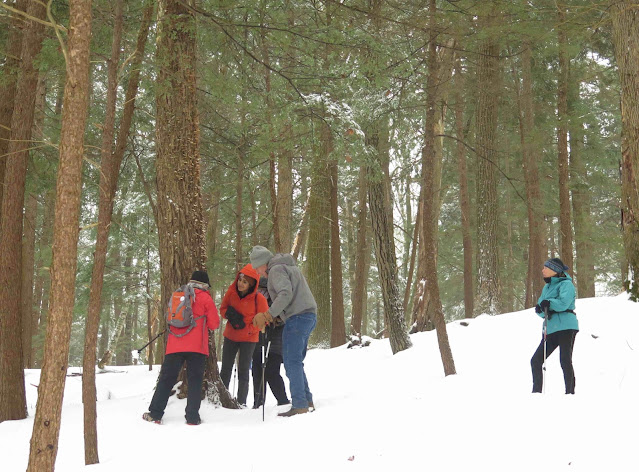We finally made it to Lake Bonita this week, my friends in the Thursday Naturalists and I, after two weeks of cancelling this trip because of bad weather. The weather this past Thursday didn't seem all that promising either, with several different forecasts all predicting something different: rain, snow, sleet, or sun, oh heck, who knows? So I told my friends, "I'll be at the parking lot atop Mt. McGregor by 10am, if anyone wants to join me." And joy of joys, a few hardy souls did turn up, dressed for whatever weather came our way. And as it happened, we did get a little of every weather, but had a great time regardless.
Lake Bonita is a lovely little mountaintop lake within Moreau Lake State Park and a wonderful place to visit in every season. But because no boating is allowed on the lake, winter is the only time we can venture out onto its frozen surface to explore the tiny sphagnum-carpeted islets that dot the surface. To reach the lake, we made our way down a steep rocky trail through a north-facing forest of mostly Eastern Hemlock, Red Oak, American Basswood, Red Maple, and White Ash. I took this photo below on a sunnier day, when sunshine cast undulating shadows on the sparkling snow cover of the forest floor. A mouse had dashed across the snow before I arrived.
The trees were much snowier on the day of our visit, up here atop Mt. McGregor. It had rained a bit instead, at lower altitudes.
The Eastern Hemlocks along the shore were heavy with cones.
When we reached the lake, we could see the little islands dotting the surface, and with good thick ice covering the lake, we had no reason to fear about setting out to explore them.
All of the islets are covered with thick mats of several different kinds of Sphagnum Moss. The Sphagnum itself creates an acidic habitat that supports the growth of many plants ordinarily found in bogs and other low-pH conditions.
The most abundant plants colonizing these islets are the three shrubs pictured here: Leatherleaf (Chamaedaphne calyculata) with dark maroon persistent leaves, Sheep Laurel (Kalmia angustifolia) with golden leaves, and Sweet Gale (Myrica gale), the bare twigs with the pointed buds in the lower right corner.
Here's a closer look at a Leatherleaf twig, already holding the buds that will produce dangling bells of white flowers in early spring.
Other Leatherleaf twigs held the open seed pods, looking like small brown flowers.
Some of the Sweet Gale shrubs bore masses of shiny mahogony-colored cone-like buds containing the flowers that will appear in early spring, golden fuzzy tufts of staminate flowers and bright-red pistillate ones, each sex on a separate shrub.
Other Sweet Gale shrubs bore the seedpods produced by the pistillate flowers, ready to spill their myriad seeds and perfume one's fingertips with a marvelously fragrant scent.
The Sheep Laurel holds onto both its leathery leaves and the remnants of its flower clusters throughout the winter.
Here and there, we found an arching wand of a fourth shrub, called Water Willow (Decodon verticillatum), which bears whorls of pretty rosy-purple flowers in summer. I have paddled ponds where this shrub completely dominates the shoreline with impenetrable thickets, but out here on the Lake Bonita islets, it is only an occasional find.
Many Speckled Alder shrubs (Alnus incana) thrive along the shore of Lake Bonita, as well as growing occasionally out on the little sphagnum-carpeted islands that dot the lake. Here and there, I found some female cones infected with a fungal plant pathogen called Alder Tongue Gall (Taphrina alni), which causes the cones to produce tangled masses of ribbon-like growths, like those pictured here. I have read that, although it distorts some of the cones of an individual tree, it does not harm the tree itself.
Northern Pitcher Plants (Sarracenia purpurea) are common inhabitants of low-pH habitats like the islets of Lake Bonita, and we were delighted to find many well-preserved remnants of their interesting flowers.
We even found one actual "pitcher" still intact and protruding above the snow.
One of my favorite summer flowers here on Lake Bonita is Marsh St. Johnswort (Hypericum virginicum), so it's fun to see abundant numbers of its attractive tulip-shaped achenes protruding through the snow cover.
Here and there I found the persistent wispy slender stalks of White Beak Sedge (Rhynchospora alba), a common denizen of bogs and fens.
We also found several bird's nests, tucked into shrubs and located low to the ground. The location alone suggested to us that this was probably the nest of a Red-winged Blackbird.
One of our friends found a fallen limb that was adorned with this very pretty combination of a small ruffly tan fungus and a green foliose lichen. I do recognize the fungus as the Crimped Gill Fungus (Plicatura crispa), but I am not sure of the lichen's ID. Possibly Green Shield Lichen? Whatever the names, what a lovely treasure to find on a walk through the winter woods!
As I mentioned before, we had a little bit of just about every kind of winter weather during our outing What felt at first like a few drops of rain soon turned into pelting ice, but for just a moment or two before morphing into feathery flakes softly floating down and turning the air white. But then the precipitation stopped as suddenly as it began, and a few moments later, patches of blue appeared in the otherwise cloudy sky. How delightful it was to have such friends who came prepared to endure whatever the weather gods threw at us, in order to cheerfully explore this beautiful and fascinating site.





















4 comments:
What a beautiful walk....thanks for sharing!
It's a good thing you were along, to identify all those shrubs in February!
It was long in coming, but a day worth waiting for !
Glad you had an interesting day with good friends.
Post a Comment